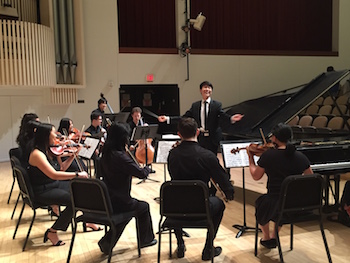In response to increased student interest in conducting, Professor Andrew Hauze introduced the Lab Orchestra in the fall of 2016 as a way to give those students practice. This spring, they performed at the Pennsylvania Academy of Fine Arts (PAFA) thanks to Concert and Production Manager Jenny Honig’s efforts to find off-campus performance opportunities for the group. This semester, Swarthmore College Lab Orchestra co-conductors Andrew Kim ’18 and Shira Samuels-Shragg ’20 have had the experience of conducting not only the Lab Orchestra, but also the Jasper String Quartet, a Philadelphia-based group of professional musicians.
“Having a lab orchestra like this is very rare for an undergraduate program,” Kim says. “This is usually a model for graduate conducting programs. I don’t know of any other conducting opportunities even at bigger universities that undergrad students can get that parallels this kind of experience… it’s remarkable what we as a small department can do and the development that has happened in the past couple years thanks to Andrew and Jenny.”
According to Shragg, the rehearsals with the Lab Orchestra have allowed her to explore different interpretations of the pieces because she can ask the group to perform the piece in different ways. “You get the score, you go through it, and you try to figure out what everything means and what ideas you want to bring to it,” Shragg says. “The perfect situation is that you have such a strong image and understanding of how you want the piece to sound that you can simultaneously hear the orchestra, what they’re playing, and the idealized version you have in your head, and bring the orchestra to meet your vision for the piece. What’s fun with Lab Orchestra is because…it’s literally like a lab, we get to play around, whereas you could never walk into an L.A. [Philharmonic] rehearsal and say ‘oh, I’d like to try this passage three different ways.’ In this setting you can do that, we have done that.”
Kim says that conducting for professional musicians has facilitated the improvement of both the student conductors and musicians. “There’s more of a direct feedback with musicians have been playing in orchestras for a long time, so they can give pointed tips that work really well both for the players and us too,” he says. “I’ve just found that everything that they say clicks with both the musicians and me a lot.” Though the group gives feedback, Kim is still able to assert his own creative agency in the pieces that he conducts. “In my two semesters of working with them, I’ve found the space that I need to still be that leader,” he says. “Even though they’re much more accomplished musicians than I am, they’re good about still giving me that space and allowing me to do what I need to do.”
According to Shragg, the Jasper String Quartet prepares her for her career path as a conductor. “It’s different, but it’s great practice because anything that we get to conduct in the real world, that’s how it’s going to be,” Shragg says.
This weekend, Shragg and Kim will debut their holiday repertoire—featuring Sir Edward Elgar’s Introduction and Allegro, Covelli’s Christmas Concerto in G minor, Op. 5, No. 8, and “Winter” from Vivaldi’s Four Seasons—at the PAFA rotunda on December 3 at 2:00 P.M. and during the second half of the Fetter Chamber Music Concert on December 2 at 8 P.M. The Jasper String Quartet will be featured in the Elgar pieces as well as performing solos in the Covelli. Kim took the Jasper String Quartet’s suggestion of the Elgar pieces because of the beauty of the music as well as the late Romantic-era style. “I think it’s a challenging piece for our group but they’ve really kind of risen to the challenges of this piece,” Kim says.
Shragg, on the other hand, will conduct the Vivaldi and Corelli pieces. She was inspired to conduct Vivaldi’s “Winter” after hearing it played during her Music Theory class. Hauze suggested the Corelli as her first piece to conduct “because unlike the Elgar, it’s not super dense. It’s still beautiful and there’s a lot to explore there but it’s more manageable,” Shragg says. The Christmas Concerto was composed to follow the story of Jesus’s birth.
The common thread that ties the pieces that both Shragg and Kim have chosen for their fall repertoire is nature. The Elgar piece an English pastoral, the Corelli has a movement called “pastorale,” and the Vivaldi has its own corresponding poem that includes lines like “shivering, frozen mid the frosty snow in biting, stinging winds; running to and fro to stamp one’s icy feet, teeth chattering in the bitter chill.” Both hope that Swarthmore students who attend their performance will be inspired by the wonder of nature, without having to feel the “teeth-chattering,” “stinging” winter weather.
“[The element of nature] is something that’s close to Swarthmore students because we go to school in an arboretum,” Kim said “I hope that at a particularly busy time of the semester it can help people to take a break and even if they’re not outside in cold nature, they can experience nature kind of vicariously in our pieces.”
Bayliss Wagner ’21
